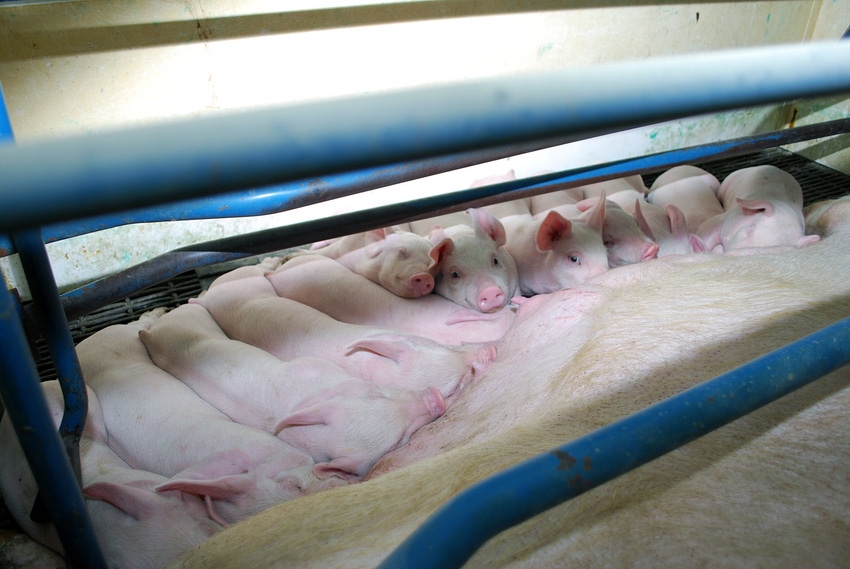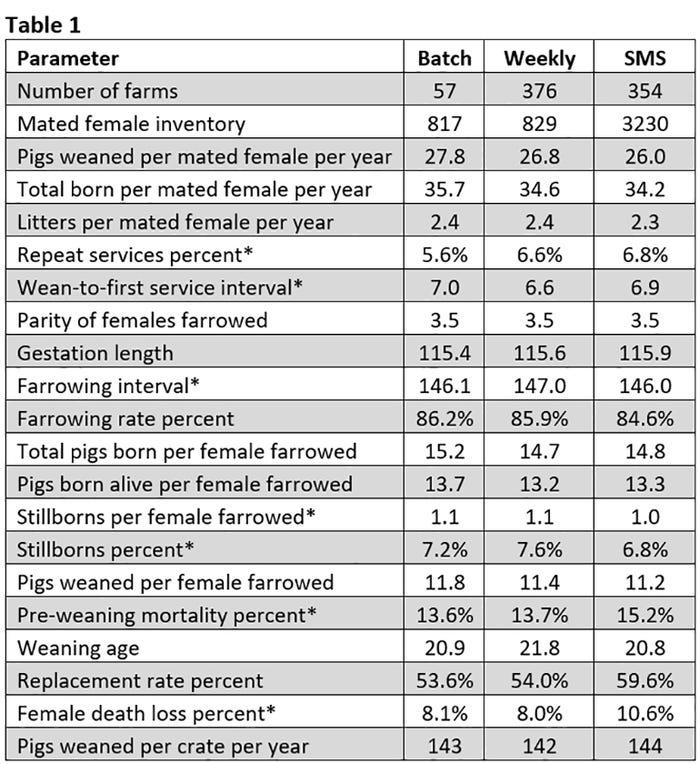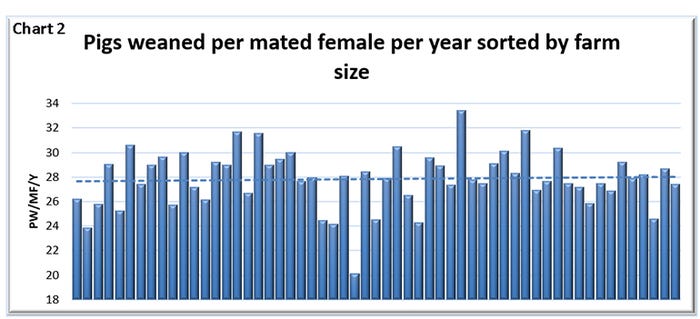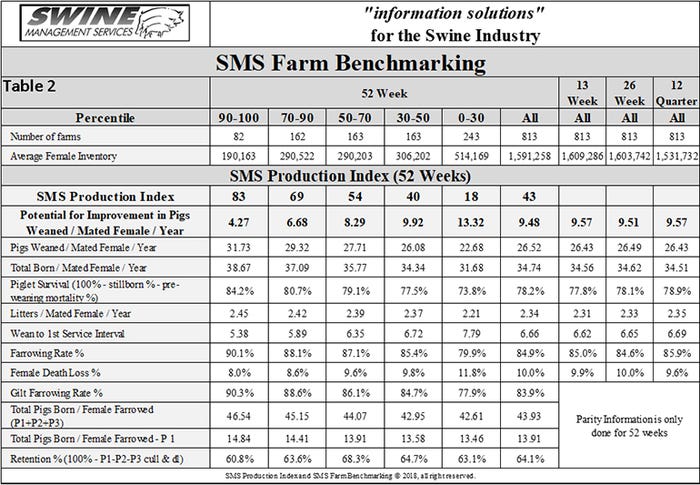Is it time for your farm to consider batch farrowing?
The greatest advantage to going to batch farrowing often comes in improved finisher performance, with lower death loss, better feed conversion and lower treatment costs.

Since the introduction of porcine epidemic diarrhea virus, there has been an increase in the number of farms going to batch farrowing, now up to 8% of the farms in the Swine Management Services database on a five-by-four batch program: five groups of sows that are four weeks apart in farrowing. Improving the health of pigs in both the farrowing house and down stream in nursery and finishing is the major driver in going to a batch system.
Farms went away from batches for a number of reasons, the biggest being that the reproductive cycle of sows doesn’t align with batches and so weekly groups allow you to breed females at any time. Another reason was to even out the work load; a four-week batch creates 10 days or so of high labor requirements followed by 18 days of lower requirements.
There are 57 farms on the 5x4, and most are smaller farms that are going to this program, but it works for large farms also with more moving in that direction. The 57 farms average 817 mated females but range in size from 202 to 1,626 mated females. There are 376 farms that are 1,626 mated females or less that are on a weekly schedule and average 829 females and range from just 92 to 1,622 mated females. Looking at the rest of the database there are 354 farms that average 3,230 mated females. In Table 1 there are some key parameters for each of these three groups. While there are some numerical differences between the groups with the batch average being better in almost all areas, they are not statistically significant.

When comparing the 57 farms to the entire SMS database for pigs weaned per mated female per year, Chart 1 shows the range in farm performance. The diamonds represent where there is a batch farm, with the red bars indicating the number of farms in each area. Pigs weaned per mated female per year at 27.8 for the batch farms compared to the SMS database at 26.5.

When evaluating pigs weaned per mated female per year in Chart 2 ranked by number of mated females for the batch farms, with the smallest farm being on the left moving to the largest farm, there isn’t a correlation in performance based on the size of the farm.

Chart 3 looks at the range in farrowing rates for both the batch farms represented as the system and the entire SMS database. The range for batch farms again is not as wide as the database as a whole. In Chart 4, the 57 batch farms are sorted by pigs weaned per mated female per year, the better the farrowing rate for a farm the higher the pigs weaned per mated female per year.


There are a number of benefits to being on a batch program and here are just a few to consider.
Improved health
This is true for the sow farm as well as the growing pigs. Despite the fact that many farms are all-in, all-out by room, the problem still exists because of the shared airspace within the barn.
Diseases can be eliminated from farms sooner because piglets are great Petri dishes.
Fewer entries to the farm for gilts, semen and trucks can help reduce the biosecurity risks.
Performance the same or better
The data here and in data shared by others in the industry show sow farm performance is the same or better.
People can sometimes tire of doing the same thing all day every day and this breaks up that routine and allows them to intensely focus on one specialized task for a few days each turn rather than every day and actually improve performance.
Grow-finish performance is often improved if you follow the same mindset, one barn is one airspace, one group of pigs.
Work flow is better
As mentioned earlier, 10 days of high labor requirements followed by 18 days of lower requirements. Vacations and time off are scheduled during those 18 days and don’t impact the rest of the staff as much as when staff takes time off on a weekly farm schedule. Staff can often be uneasy about the change, help them through it by allowing them to talk to other farms that have gone through the transition.
It allows more time to perform routine maintenance on the farm.
If you have two farms with the same health status, have them on opposite schedules and allow some team members to float between the two for a more balanced workflow.
It is not as difficult to move to a batch program as it once was, with the heat synchronization products available this is much less complicated. The first cycle through the transition will likely result in some smaller weaned pigs and a younger wean age. The improved health of the pigs will help make up for the smaller pigs. Another obstacle with a batch program is the limited number of nurse sows available, this is something that takes some time to adjust to but as indicated above really see no difference in performance. The greatest advantage to going to batch farrowing often comes in improved finisher performance, with lower death loss, better feed conversion and lower treatment costs. If you are in a pig-dense area or struggle with disease converting to batch farrowing is certainly something you should consider.
♦
Table 2 provides the 52-week rolling averages for 11 production numbers represented in the SMS Production Index. The numbers are separated by 90-100%, the 70-90%, the 50-70%, the 30-50% and the 0-30% groups. We also included the 13-week, 26-week and 12-quarter averages. These numbers represent what we feel are the key production numbers to look at to evaluate the farm’s performance.

At SMS, our mission statement is to provide “Information solutions for the swine industry.” We feel with the creation of different SMS Benchmarking databases for all production areas we now have more detailed information to share with the swine industry. If your farm would like to be part of the SMS Benchmarking databases, or if you have suggestions on production areas to write columns about, contact Mark Rix, Ron Ketchem or Valerie Duttlinger. We enjoy being a part of the NHF Daily team. Previous columns can be found at NationalHogFarmer.com.
Sources: Ron Ketchem, Mark Rix and Valerie Duttlinger, who are solely responsible for the information provided, and wholly own the information. Informa Business Media and all its subsidiaries are not responsible for any of the content contained in this information asset.
About the Author(s)
You May Also Like



